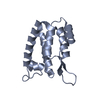+ Open data
Open data
- Basic information
Basic information
| Entry | Database: PDB / ID: 8erg | ||||||
|---|---|---|---|---|---|---|---|
| Title | HTLV-1 capsid protein N-terminal domain hexagonal crystal form | ||||||
 Components Components | capsid protein p24 | ||||||
 Keywords Keywords | VIRAL PROTEIN / capsid | ||||||
| Function / homology |  Function and homology information Function and homology informationviral nucleocapsid / nucleic acid binding / viral translational frameshifting / structural molecule activity / zinc ion binding Similarity search - Function | ||||||
| Biological species |  HTLV-1 subtype C (virus) HTLV-1 subtype C (virus) | ||||||
| Method |  X-RAY DIFFRACTION / X-RAY DIFFRACTION /  SYNCHROTRON / SYNCHROTRON /  MOLECULAR REPLACEMENT / MOLECULAR REPLACEMENT /  molecular replacement / Resolution: 2.1 Å molecular replacement / Resolution: 2.1 Å | ||||||
 Authors Authors | Yu, R.J. / Li, N. / Jacques, D.A. | ||||||
| Funding support |  United Kingdom, 1items United Kingdom, 1items
| ||||||
 Citation Citation |  Journal: To Be Published Journal: To Be PublishedTitle: HTLV-1 capsid protein N-terminal domain hexagonal crystal form Authors: Yu, R.J. / Li, N. / Jacques, D.A. | ||||||
| History |
|
- Structure visualization
Structure visualization
| Structure viewer | Molecule:  Molmil Molmil Jmol/JSmol Jmol/JSmol |
|---|
- Downloads & links
Downloads & links
- Download
Download
| PDBx/mmCIF format |  8erg.cif.gz 8erg.cif.gz | 85.3 KB | Display |  PDBx/mmCIF format PDBx/mmCIF format |
|---|---|---|---|---|
| PDB format |  pdb8erg.ent.gz pdb8erg.ent.gz | 64.2 KB | Display |  PDB format PDB format |
| PDBx/mmJSON format |  8erg.json.gz 8erg.json.gz | Tree view |  PDBx/mmJSON format PDBx/mmJSON format | |
| Others |  Other downloads Other downloads |
-Validation report
| Summary document |  8erg_validation.pdf.gz 8erg_validation.pdf.gz | 812.4 KB | Display |  wwPDB validaton report wwPDB validaton report |
|---|---|---|---|---|
| Full document |  8erg_full_validation.pdf.gz 8erg_full_validation.pdf.gz | 813.3 KB | Display | |
| Data in XML |  8erg_validation.xml.gz 8erg_validation.xml.gz | 6.9 KB | Display | |
| Data in CIF |  8erg_validation.cif.gz 8erg_validation.cif.gz | 8.3 KB | Display | |
| Arichive directory |  https://data.pdbj.org/pub/pdb/validation_reports/er/8erg https://data.pdbj.org/pub/pdb/validation_reports/er/8erg ftp://data.pdbj.org/pub/pdb/validation_reports/er/8erg ftp://data.pdbj.org/pub/pdb/validation_reports/er/8erg | HTTPS FTP |
-Related structure data
| Related structure data | |
|---|---|
| Similar structure data | Similarity search - Function & homology  F&H Search F&H Search |
- Links
Links
- Assembly
Assembly
| Deposited unit | 
| ||||||||
|---|---|---|---|---|---|---|---|---|---|
| 1 | 
| ||||||||
| Unit cell |
|
- Components
Components
| #1: Protein | Mass: 14144.993 Da / Num. of mol.: 1 Source method: isolated from a genetically manipulated source Source: (gene. exp.)  HTLV-1 subtype C (virus) / Production host: HTLV-1 subtype C (virus) / Production host:  |
|---|---|
| #2: Chemical | ChemComp-SO4 / |
| #3: Water | ChemComp-HOH / |
| Has ligand of interest | Y |
-Experimental details
-Experiment
| Experiment | Method:  X-RAY DIFFRACTION / Number of used crystals: 1 X-RAY DIFFRACTION / Number of used crystals: 1 |
|---|
- Sample preparation
Sample preparation
| Crystal | Density Matthews: 2.1 Å3/Da / Density % sol: 41.32 % |
|---|---|
| Crystal grow | Temperature: 293 K / Method: vapor diffusion, sitting drop / pH: 7.5 / Details: 2 M (NH4)SO4, 2% PEG 400, 0.1 M HEPES, pH7.5 |
-Data collection
| Diffraction | Mean temperature: 100 K / Serial crystal experiment: N | ||||||||||||||||||||||||||||||
|---|---|---|---|---|---|---|---|---|---|---|---|---|---|---|---|---|---|---|---|---|---|---|---|---|---|---|---|---|---|---|---|
| Diffraction source | Source:  SYNCHROTRON / Site: SYNCHROTRON / Site:  Australian Synchrotron Australian Synchrotron  / Beamline: MX2 / Wavelength: 0.9537 Å / Beamline: MX2 / Wavelength: 0.9537 Å | ||||||||||||||||||||||||||||||
| Detector | Type: DECTRIS EIGER2 S 16M / Detector: PIXEL / Date: Apr 8, 2022 | ||||||||||||||||||||||||||||||
| Radiation | Protocol: SINGLE WAVELENGTH / Monochromatic (M) / Laue (L): M / Scattering type: x-ray | ||||||||||||||||||||||||||||||
| Radiation wavelength | Wavelength: 0.9537 Å / Relative weight: 1 | ||||||||||||||||||||||||||||||
| Reflection | Resolution: 2.05→48.61 Å / Num. obs: 7949 / % possible obs: 98.6 % / Redundancy: 33.2 % / Biso Wilson estimate: 32.81 Å2 / CC1/2: 0.998 / Rmerge(I) obs: 0.15 / Rpim(I) all: 0.026 / Rrim(I) all: 0.152 / Net I/σ(I): 17.4 / Num. measured all: 263835 / Scaling rejects: 74 | ||||||||||||||||||||||||||||||
| Reflection shell | Diffraction-ID: 1
|
-Phasing
| Phasing | Method:  molecular replacement molecular replacement | |||||||||
|---|---|---|---|---|---|---|---|---|---|---|
| Phasing MR |
|
- Processing
Processing
| Software |
| ||||||||||||||||||||||||||||||||||||||||
|---|---|---|---|---|---|---|---|---|---|---|---|---|---|---|---|---|---|---|---|---|---|---|---|---|---|---|---|---|---|---|---|---|---|---|---|---|---|---|---|---|---|
| Refinement | Method to determine structure:  MOLECULAR REPLACEMENT MOLECULAR REPLACEMENTStarting model: AlphaFold2 prediction Resolution: 2.1→48.61 Å / SU ML: 0.3 / Cross valid method: THROUGHOUT / σ(F): 1.38 / Phase error: 28.39 / Stereochemistry target values: ML
| ||||||||||||||||||||||||||||||||||||||||
| Solvent computation | Shrinkage radii: 0.9 Å / VDW probe radii: 1.11 Å / Solvent model: FLAT BULK SOLVENT MODEL | ||||||||||||||||||||||||||||||||||||||||
| Displacement parameters | Biso max: 124.27 Å2 / Biso mean: 43.7232 Å2 / Biso min: 18.59 Å2 | ||||||||||||||||||||||||||||||||||||||||
| Refinement step | Cycle: final / Resolution: 2.1→48.61 Å
| ||||||||||||||||||||||||||||||||||||||||
| LS refinement shell | Refine-ID: X-RAY DIFFRACTION / Rfactor Rfree error: 0 / Total num. of bins used: 5 / % reflection obs: 100 %
| ||||||||||||||||||||||||||||||||||||||||
| Refinement TLS params. | Method: refined / Origin x: -4.4039 Å / Origin y: 26.1514 Å / Origin z: 17.0932 Å
| ||||||||||||||||||||||||||||||||||||||||
| Refinement TLS group | Selection details: (chain 'A' and resid 1 through 127) |
 Movie
Movie Controller
Controller





 PDBj
PDBj



